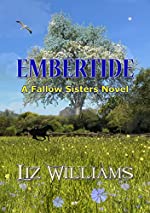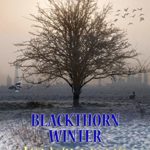Liz Williams’ Embertide is the third outing with the Fallow Sisters (following on from Comet Weather and Blackthorn Winter), and it’s another time-slipping and spirit-battling adventure with Bee, Serena, Stella, Luna, and their reality jumping Mom, Alys. Spirits, both good and evil, frequently interrupt their lives in present-day England. Assisting them are a troupe of friends, including some baseline humans but also various ghosts, shapeshifters, reborn time-hopping folks or the avatars of stars or ancient goddesses.
One of the things I love about this series is the ordinariness of the sisters’ encounters with the spirit realms. The four of them try to carry on with their daily lives (Stella is a DJ, Serena a clothing designer, Luna a sort of free roamer, and Bee the keeper of the family hearth at Mooncote) but they are not too surprised if that pier in Brighton suddenly slips into the 1940s or the 1890s. Or if that ugly corner of London turns out to be the involuntary home of a huntress spirit named Noualen, or if that country lane becomes a hollow overrun by a herd of cattle that are really human spirits. Each incident begins with barely any warning, maybe a change of light or a tree appearing where none had been before, and they are off.
While the Fallow sisters and their close friends try to use the spiritual sight they have for benevolent purposes, they are dogged by a more malevolent crowd. In earlier novels, the famous actor Miranda Dean (who is also in and out of the spirit world) is always going after Serena, whose partner Ward, also a well-known actor, was once Miranda’s lover. But in Embertide it is Stella she seems to pursue in order to fulfill a bargain she struck with very dark forces. There is the man with goat’s eyes and threatening hounds who leads the Hunt for souls, and those white shoots coming out of the ground seem to be warriors, as in the legend of dragon’s teeth sown in the soil that rise up as warriors and fight each other to the death. So many strange people suddenly appear to the sisters that they keep having to check if they are part of this world or something else entirely.
Embertide puts together a series of increasingly strange events, at first occurring on the periphery of awareness but gradually demanding more and more attention until they swoop up one or more of the sisters in sinister and nearly fatal encounters. They have to get out of them alive and hopefully, while doing so, destroying the malevolent beings. When necessary, especially at the most threatening moments, each can turn into an animal form, Luna becoming a wren, Bee a swarm of bees, and in this story Stella finds she can become an otter to escape Miranda’s clutches.
That’s pretty much how each novel works. They are entertaining, often because each of the sisters is fun to spend time with, and there is a broad story arc as we learn more about the sisters in each book. But there’s no great character development, though there are revelations about their powers and history aplenty. The adventures don’t change anyone much, and while the stories always have exciting clashes and life-and-death battles, these are basically comedies in the sense that all works out well in the end.
The preface to Embertide tells you at the outset that the mother Alys, known in the spirit world as Far Farer, meets a strange man, who has yellow eyes and ram’s horns and leads something called the Hunt. He says he wants her help in capturing a horse, and in return he will be sure she has safe passage across the country during a dangerous time when a great tide is coming and deathly spirits will be searching for souls. She goes off with him, promising only to think about his proposal, while behind her a body swings from a gibbet. Those are critical details that shape much of what happens in the rest of the story, but when Alys reappears to her daughters and lives with them for a while, she does not mention this agreement she is considering. The daughters encounter one strange event after another, most of which appear malevolent, but Alys maintains her silence, often disappearing for a time, until the end when she finally reveals a few of her secrets, but not everything.
For me the defining quality of the sisters, and their whole extended family, is the way they respond to the land. Not only do they sense all the subtle seasonal changes of plants and landscape, they also experience the spiritual substrate of the surface features of trees, towns, bridges, buildings, which change over time, and often have to trace the ley lines through the world as the only true guides. But that doesn’t mean that the land is always a haven. Quite the contrary. At times it feels “simmering, deceptive”, a force to be wary of since it can take dangerous forms and harbor spirits that can kill if you get in their way.
In Blackthorn Winter, it became clear that there was no comprehensive map of England in its spirit form. People as well as the spirits they interact with only glimpse fragments of the whole, yet there is a beautiful evocation late in Embertide of the region around London as a palimpsest, with layer upon layer of changes in the landscape over thousands of years as well as the human structures built upon it. It is dotted with stable points, known as coldharbours, that offer guidance to anyone, human or spirit, trying to navigate its changes.
There is a theme of social protest through Embertide, for it turns out that often the spirits have been constrained by the way in which England has been “locked up,” and the country hedged in, carved up, and “sold by the pound” through “ancient bargains, tithes and land rights.” The spirit beings want their freedom to roam as they once could before there were boundaries, and at times they turn to humans for help to regain a small part of their freedom. And a central scene of action takes place at a protest to block earth-moving equipment at the foot of Glastonbury Tor. The story is all about the mix-up of spirits and humans in a jumble that will never be straightened out completely, but there are moments when a bit of freedom is restored, a little more knowledge of how to navigate the spirit world is gained and a hope of cooperation takes the place of endless scheming and fighting.
As with the previous books, there are a lot of questions only partly answered at the end of Embertide, so I hope there will be more in this series. Above all, it will be interesting to see what happens after the very pregnant Luna gives birth (to a child of what sort of powers?), to learn more about her lover Sam’s Traveller family, and to find out more about what Alys has been up to in all her wanderings. I’m on board for anything Liz Williams writes. Her beautiful style is carefully attuned to both harmony and discordance of the ancient land and the people struggling to understand it.





Leave a Reply